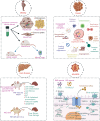Tackling exosome and nuclear receptor interaction: an emerging paradigm in the treatment of chronic diseases
- PMID: 39327610
- PMCID: PMC11426102
- DOI: 10.1186/s40779-024-00564-1
Tackling exosome and nuclear receptor interaction: an emerging paradigm in the treatment of chronic diseases
Abstract
Nuclear receptors (NRs) function as crucial transcription factors in orchestrating essential functions within the realms of development, host defense, and homeostasis of body. NRs have garnered increased attention due to their potential as therapeutic targets, with drugs directed at NRs demonstrating significant efficacy in impeding chronic disease progression. Consequently, these pharmacological agents hold promise for the treatment and management of various diseases. Accumulating evidence emphasizes the regulatory role of exosome-derived microRNAs (miRNAs) in chronic inflammation, disease progression, and therapy resistance, primarily by modulating transcription factors, particularly NRs. By exploiting inflammatory pathways such as protein kinase B (Akt)/mammalian target of rapamycin (mTOR), nuclear factor kappa-B (NF-κB), signal transducer and activator of transcription 3 (STAT3), and Wnt/β-catenin signaling, exosomes and NRs play a pivotal role in the panorama of development, physiology, and pathology. The internalization of exosomes modulates NRs and initiates diverse autocrine or paracrine signaling cascades, influencing various processes in recipient cells such as survival, proliferation, differentiation, metabolism, and cellular defense mechanisms. This comprehensive review meticulously examines the involvement of exosome-mediated NR regulation in the pathogenesis of chronic ailments, including atherosclerosis, cancer, diabetes, liver diseases, and respiratory conditions. Additionally, it elucidates the molecular intricacies of exosome-mediated communication between host and recipient cells via NRs, leading to immunomodulation. Furthermore, it outlines the implications of exosome-modulated NR pathways in the prophylaxis of chronic inflammation, delineates current limitations, and provides insights into future perspectives. This review also presents existing evidence on the role of exosomes and their components in the emergence of therapeutic resistance.
Keywords: Chronic diseases; Exosomes; Inflammation; MicroRNAs; Nuclear receptors.
© 2024. The Author(s).
Conflict of interest statement
The authors declare that they have no competing interests.
Figures





References
-
- Meetoo D. Chronic diseases: the silent global epidemic. Br J Nurs. 2008;17(21):1320–5. - PubMed
-
- World Health Organization. The top 10 causes of death. World Health Organization; 2020 [cited 2nd July 2024]. Available from: https://www.who.int/news-room/fact-sheets/detail/the-top-10-causes-ofdea....
-
- Nishtar S, Niinisto S, Sirisena M, Vazquez T, Skvortsova V, Rubinstein A, et al. Time to deliver: report of the WHO independent high-level commission on NCDs. Lancet. 2018;392(10143):245–52. - PubMed
Publication types
MeSH terms
Substances
LinkOut - more resources
Full Text Sources
Miscellaneous

